All matter in the universe came from the Big Bang, about 13.8 billion years ago. It started as a hot, dense singularity that expanded and cooled. As it cooled, energy transformed into matter through processes like primordial nucleosynthesis, forming light elements such as hydrogen and helium. Gravity played a significant role, pulling together these elements to form stars and galaxies. Stellar interactions created heavier elements and scattered them across space. This intricate process set the foundation for everything we see today. If you're curious about how these elements continue to shape the universe, there's a lot more to explore.
Essential Insights
- Matter originated from the Big Bang, evolving from a singularity into energy and then to light elements during primordial nucleosynthesis.
- Initial cooling of the universe allowed the formation of hydrogen and helium, which are the most abundant elements.
- Stellar nucleosynthesis in stars converted lighter elements into heavier ones, enriching the cosmic composition through supernova explosions.
- Gravity played a crucial role in the formation of structures, pulling together matter and facilitating the creation of stars and galaxies.
- Quantum physics reveals that matter behaves in complex ways, with particle interactions and unique processes contributing to its creation and properties.
The Big Bang Explained
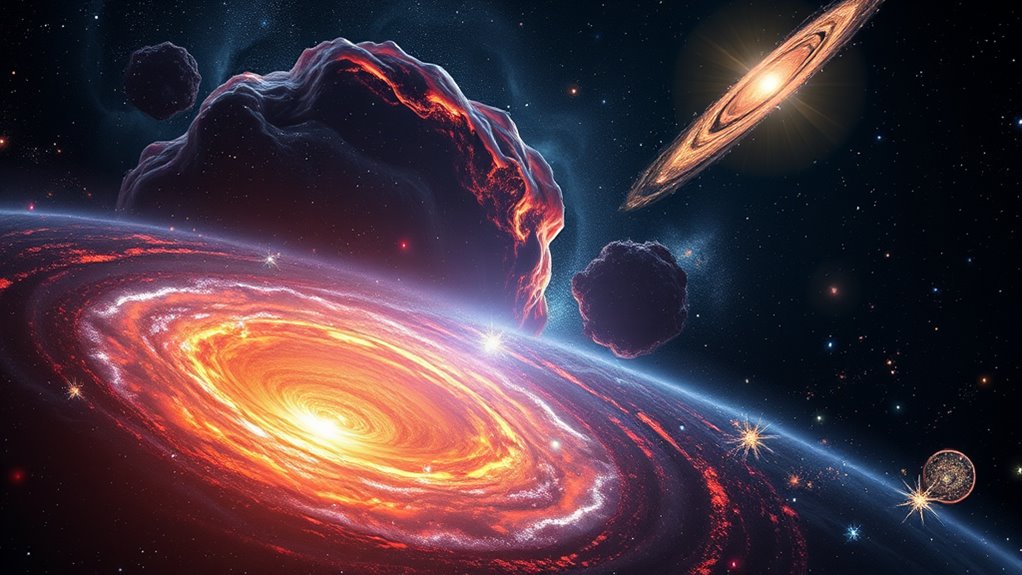
The Big Bang hypothesis kicks off our understanding of the universe's origins, suggesting that all matter came into existence about 13.8 billion years ago. At that moment, everything was compacted into an infinitely dense and hot state called a Singularity.
Then, this Singularity began expanding—not as an explosion in space, but as space itself began to appear everywhere. This initial phase marks the start of cosmic inflation, a rapid expansion that shaped the universe's early structure.
As the universe expanded, it began to cool. During this cooling phase, the energy evolved from mostly radiation to matter, a process that led to primordial nucleosynthesis. This is the period when the first light elements, such as hydrogen and helium, formed.
As densities decreased, the character of energy shifted, allowing particles to take on mass and velocity, setting the stage for the complex structures we observe today. The Lambda-Cold Dark Matter model serves as the standard model for understanding how these structures formed and evolved.
Evidence supporting this hypothesis includes the observation of distant galaxies, which exhibit redshift, confirming that the universe is still expanding. Additionally, the cosmic microwave background radiation (CMBR) serves as a remnant of the high-temperature conditions following the Big Bang.
These observations, along with the large-scale structure of the universe, reinforce the Big Bang model as a compelling explanation for our current understanding of cosmic origins. Through ongoing research, scientists continue to explore the universe's early moments, piecing together the intricate puzzle of its formation and evolution.
Formation of Protons and Neutrons
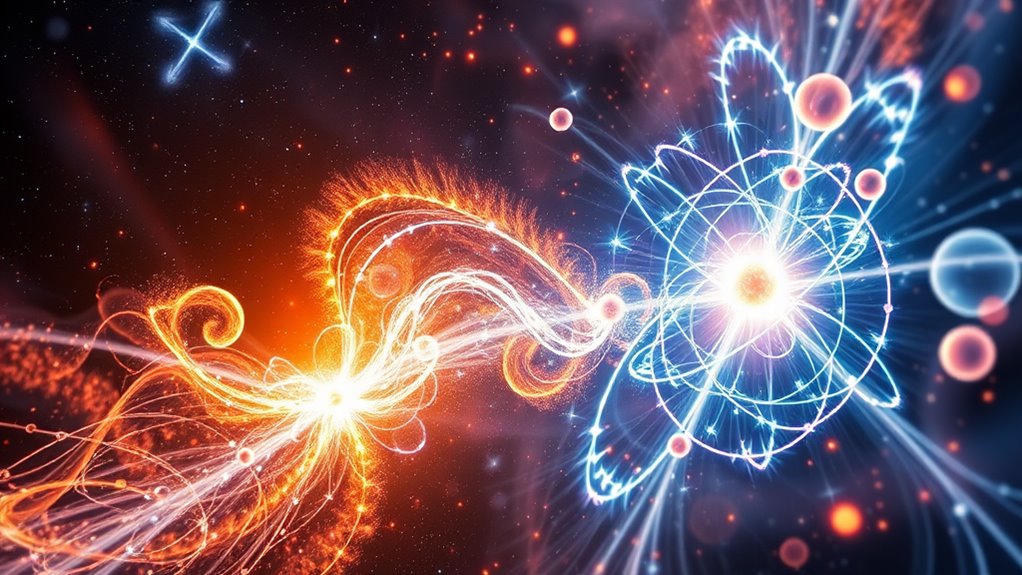
Shortly after the Big Bang, a fascinating transformation occurred as the universe cooled, leading to the formation of protons and neutrons. This pivotal moment unfolded just tens of microseconds after the explosion, marking the end of an era dominated by quark confinement. During this time, the universe evolved from a hot quark-gluon plasma to stable hadrons.
Here are some key points about this process:
- Quark Composition: Protons consist of two up quarks and one down quark, while neutrons have one up quark and two down quarks, all bound by gluons.
- Neutron Decay: Before nucleosynthesis, some neutrons decayed into protons, influencing the neutron-proton ratio.
- Stability Against Annihilation: As the universe cooled, matter and antimatter annihilated, leaving behind stable protons and neutrons.
- Final Ratios: The neutron-proton ratio shifted from about 1:1 to roughly 1:7 due to interactions and the lower mass of protons.
As the universe expanded, the conditions allowed for protons and neutrons to become stable building blocks of matter. The formation of elements during this period was crucial for the development of the universe's structure.
The rapid decay of mesons and other unstable particles guaranteed that only the stable protons and neutrons remained. This transformed the early universe into a matter-dominated domain, setting the stage for the future creation of atomic nuclei.
Fundamentally, this significant formation period laid the groundwork for everything we see in the universe today.
Creation of Atoms
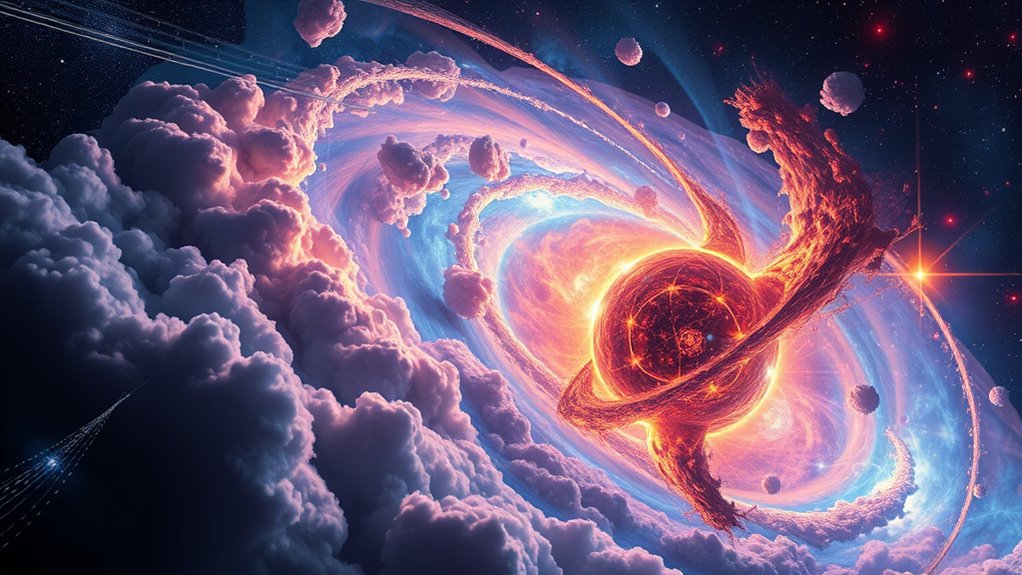
As the universe continued to cool and expand after the Big Bang, the essential building blocks of matter began to take shape in the form of atoms. During the early minutes of this cosmic journey, light element formation took place. Hydrogen and helium became stable, accompanied by trace amounts of lithium, through various nuclear reactions in the early universe. Amazingly, hydrogen makes up about 93% of the atoms, marking an essential foundation for all matter.
In fact, the concept of atoms as fundamental building blocks of matter has been a cornerstone of scientific inquiry since ancient times. But the story doesn't end here. As the universe aged, gravity kicked in, leading to the formation of the first stars. Within their cores, a process known as stellar nucleosynthesis began, creating heavier elements from these initial light elements. High temperatures and densities in these stellar environments allowed hydrogen atoms to fuse, forming helium and even heavier elements.
This process not only produced a diverse array of atoms but also contributed to the complex tapestry of the universe. When these stars eventually exploded in supernova events, they scattered these newly formed elements across the cosmos.
This cosmic distribution enriched the surrounding space, allowing for the creation of new stars and planets. So, the journey of atomic creation you see today traces back to that explosive moment of the Big Bang, evolving through light element formation and culminating in the stellar processes that birthed the variety of atoms we encounter in the universe.
The Role of Gravity
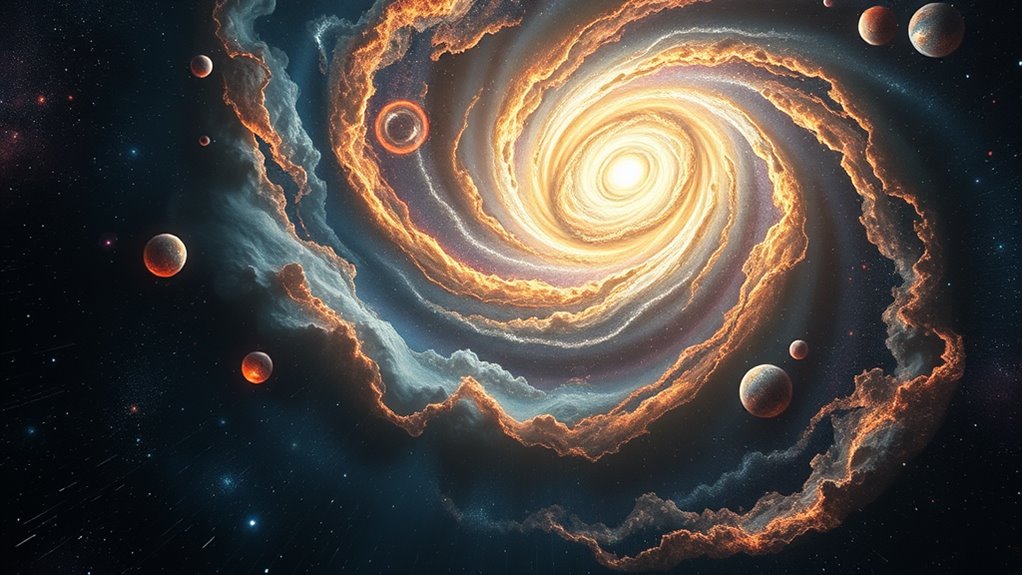
Gravity plays a pivotal role in shaping the universe, influencing everything from the formation of stars to the structure of galaxies. Its effects are profound and can be summarized in the following ways:
- Galactic Clustering: Gravity pulls together dark matter and gas, forming large clouds that eventually lead to galaxy formation.
- Stellar Dynamics: It governs the behavior of stars, determining their orbits and interactions within galaxies.
- Protostar Stages: Gravitational collapse initiates the protostar stages, where gas and dust coalesce, increasing density and temperature, creating the conditions for nuclear fusion. This process ultimately leads to the birth of a stable star, which shines in visible light as nuclear fusion continues.
- Element Synthesis: As stars evolve, gravity enables the fusion of protons into heavier elements, essential for life.
Throughout cosmic evolution, gravity shapes the universe's structure and balances universal expansion. It warps space-time, affecting light paths and time around massive objects. Gravitational waves, ripples in space-time caused by massive celestial events, also showcase gravity's far-reaching influence.
In the early universe, gravity played a significant role in curbing expansion, allowing for the formation of the first stars and galaxies. The interplay between dark matter and gravity is vital for the clustering of matter necessary for element synthesis.
Without gravity, the universe wouldn't have evolved into the complex web of galaxies, stars, and planets we see today. Its force is the backbone of cosmic creation, shaping not only the physical structures but also the elements that form the building blocks of life.
Later Reactions in Matter Formation

How did the intricate tapestry of matter we see today come to be? Following the initial formation of quarks and gluons, the universe underwent significant transformations through particle interactions that shaped the matter we observe.
As the universe cooled, quarks combined to form protons and neutrons. Shortly thereafter, electrons and positrons emerged, setting the stage for nuclei formation.
Around three to four minutes after the Big Bang, protons and neutrons fused to create deuterium, helium, and lithium nuclei. This cosmic fusion during those early moments produced nearly 70% of some particles measured today. The universe's expansion and cooling were vital, allowing these nuclei to form and survive in a rapidly changing environment.
However, it's important to understand that most of the matter we see now comes from later reactions, not just the initial formation. Subsequent particle interactions, particularly in stars, continued the process of element formation. New research indicates that nearly 70% of measured particles result from these later reactions, challenging previous beliefs about matter's timeline.
The fusion reactions in these stellar bodies produced heavier elements, enriching the universe's composition beyond the light elements formed just after the Big Bang.
Observations show that the abundances of elements like helium and deuterium support theories of the Big Bang and the significance of later reactions.
Understanding these processes helps you appreciate the complexity of matter formation and the universe's evolution, revealing how interconnected the early universe's conditions are with the matter we experience today.
Simulating Matter Creation

Researchers frequently explore innovative ways to simulate matter creation in laboratory settings. One promising method involves photon-photon collisions, where intense lasers interact with dense plasma to create conditions similar to those in the early universe.
Here are four key aspects of this approach:
- Photon-Photon Collisions: By creating high-energy environments, researchers can study how energy transforms into matter.
- Dense Plasma Utilization: Dense plasma self-organizes, forming a collider that boosts gamma ray densities, enhancing collision rates.
- Positron Beam Generation: The simulations show potential for accelerating positrons through the linear Breit-Wheeler process under relativistic conditions. This process allows for the generation of electron-positron pairs through photon interactions.
- Feasibility of Implementation: With existing technology, the experimental setup is straightforward and anticipated to be achievable soon.
This method not only tests long-standing theories like the Standard Model of particle physics but also provides insights into the primordial universe.
The interactions within dense plasma enable researchers to directly generate matter from light, a vital step in understanding the universe's fundamental composition.
Quantum Physics and Matter

Quantum physics fundamentally reshapes our understanding of matter, revealing that everything around you, from everyday objects to the stars, is composed of tiny particles that behave in ways that defy classical intuition.
At the heart of this transformation is the concept of wave-particle duality, where light and matter exhibit properties of both particles and waves. For instance, electrons exist in orbitals, described by probabilities rather than fixed positions. They can jump between these orbitals, but you won't find them in between, emphasizing the non-intuitive nature of quantum behavior.
Moreover, the introduction of quanta by Max Planck in 1900 marked a significant shift, showing that energy is absorbed and emitted in discrete bundles. This means that the interactions of matter aren't continuous but rather occur in distinct steps, governed by quantum laws.
Quantum entanglement effects further complicate our understanding; particles can become interconnected in ways that allow the state of one particle to instantaneously affect another, regardless of distance. This phenomenon challenges traditional notions of locality and separateness, reshaping how you think about the universe.
In essence, quantum physics provides a framework that describes matter at a fundamental level, where classical physics falls short. By embracing the complexities of quantum principles, you gain deeper insight into the very fabric of reality and the intricate dance of particles that form all matter around you.
Theoretical Models of Matter
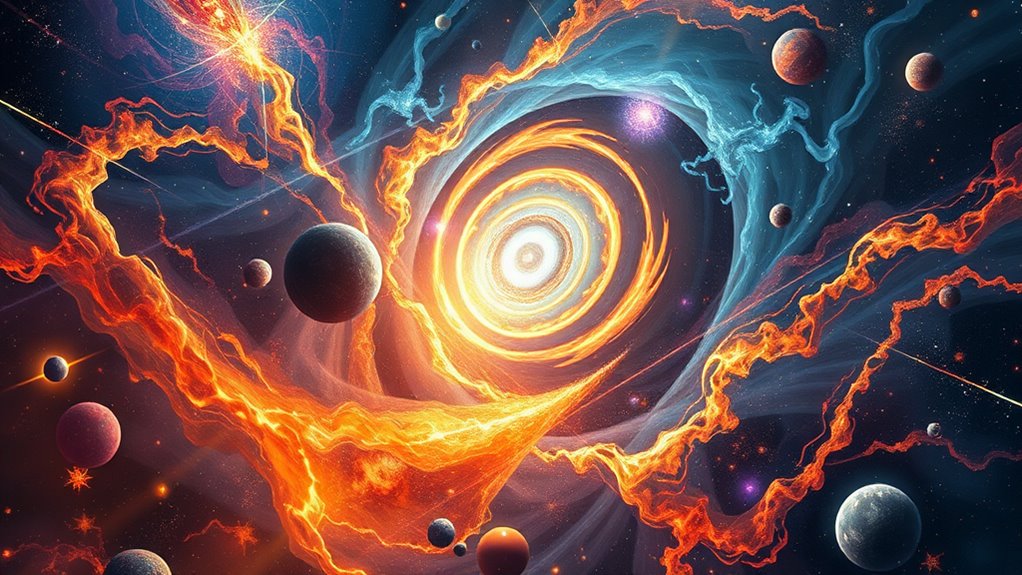
Understanding matter's composition through quantum physics sets the stage for exploring theoretical models that explain its behavior. The particle theory of matter is central to these models, highlighting how tiny particles interact and how those interactions define the properties of matter. Here are some key points to reflect on:
- Particle Composition: All matter consists of atoms or molecules, which are in constant motion.
- State Variability: The arrangement and movement of particles change based on the state of matter—solids, liquids, and gases.
- Attraction Forces: Particle interactions differ across states; solids have strong attractions, while gases exhibit minimal forces between particles.
- Temperature Influence: Higher temperatures accelerate particle motion, affecting how matter behaves.
As you investigate deeper into these models, you'll discover that understanding particle interactions is essential for grasping how matter properties manifest.
For instance, in solids, particles are tightly packed and vibrate in place, while in liquids, they can slide past one another. Gases, on the other hand, involve widely spaced particles that move freely.
Moreover, the particle model not only illustrates these behaviors but also links to concepts like pressure, volume, and temperature.
Implications for Cosmology
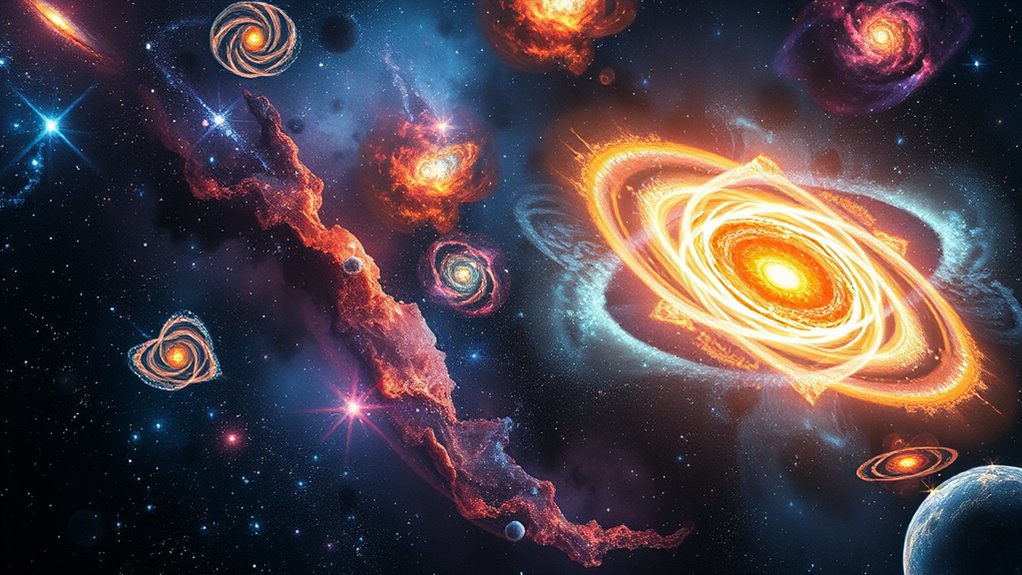
The implications for cosmology stemming from the origins of matter are profound and complex. Understanding how matter dominance emerged requires grappling with the baryon asymmetry that characterizes our universe. The early universe, teeming with particle-antiparticle interactions, should've produced equal amounts of both. Yet, a slight excess of matter survived these annihilations, leading to the cosmos we see today. This imbalance invites you to explore the mechanisms behind it, such as the leptogenesis mechanism and the role of cosmic inflation in shaping the universe's structure.
Here's a breakdown of the key concepts:
| Concept | Description |
|---|---|
| Matter Dominance | Universe primarily composed of matter, not antimatter |
| Cosmic Inflation | Rapid expansion post-Big Bang influencing structure |
| Baryon Asymmetry | Unequal amounts of matter vs. antimatter |
The multiverse hypothesis offers intriguing possibilities, suggesting that our universe's constants are finely tuned among countless others. Future observational evidence from experiments like SPHEREx and precision measurements from the cosmic microwave background will be pivotal. They might reveal insights into the subtle differences in behavior between matter and antimatter, shedding light on why matter reigns supreme.
Ultimately, resolving the mystery of matter's dominance could revolutionize your understanding of the universe's early moments and its overall structure, challenging existing cosmological theories and opening doors to new ones.
Frequently Asked Questions
What Is Dark Matter and How Does It Relate to Normal Matter?
Dark matter's a mysterious substance that makes up about 27% of the universe, yet it doesn't interact with light like normal matter does.
You can't see it directly, but you can observe its gravitational effects on galaxies and galaxy clusters.
While normal matter forms stars and planets, dark matter's presence helps explain the structure and motion of these celestial bodies.
Understanding both is vital for grasping the universe's overall dynamics.
How Do Black Holes Affect the Distribution of Matter in the Universe?
Imagine a cosmic dance where black holes lead, their merges creating ripples in the fabric of space—gravitational waves.
As they swirl together, they pull in surrounding matter, a process known as accretion, and reshape the universe's distribution.
Beyond their event horizon, matter is transformed, fueling the growth of dark energy.
You witness how these celestial giants influence the balance of normal matter, altering the cosmic tapestry with every cosmic interaction.
Can Matter Be Created From Nothing According to Physics?
Yes, matter can be created from nothing according to physics.
You'll find that quantum fluctuations in vacuum energy can lead to the spontaneous emergence of particle-antiparticle pairs. This phenomenon, rooted in quantum field theory, suggests that even empty space is teeming with potential.
When conditions are right, such as in strong electric fields, these particles can manifest, demonstrating how the universe's fabric allows matter to appear seemingly from nowhere.
What Are the Implications of Antimatter in the Universe's Matter Composition?
When you ponder the universe's delicate balance, the implications of antimatter in its composition reveal a mysterious dance.
Antimatter's properties—opposite electric charges and equal mass to matter—underscore a profound matter asymmetry. This imbalance, where matter triumphs over antimatter, hints at intriguing secrets within the laws of nature.
Understanding this discrepancy is crucial, as it shapes the cosmos, influencing everything from star formation to the very existence of life as you know it.
How Does Cosmic Radiation Influence Matter Formation in the Early Universe?
Cosmic radiation played an essential role in matter formation in the early universe.
As the universe cooled, radiation density decreased, allowing primordial nucleosynthesis to occur. Protons and neutrons combined to form light elements, mainly helium.
The cosmic microwave background (CMB) emerged when the universe reached a temperature low enough for electrons to bind with nuclei, enabling photons to travel freely.
This shift marked a significant step towards the formation of the structures we see today.
